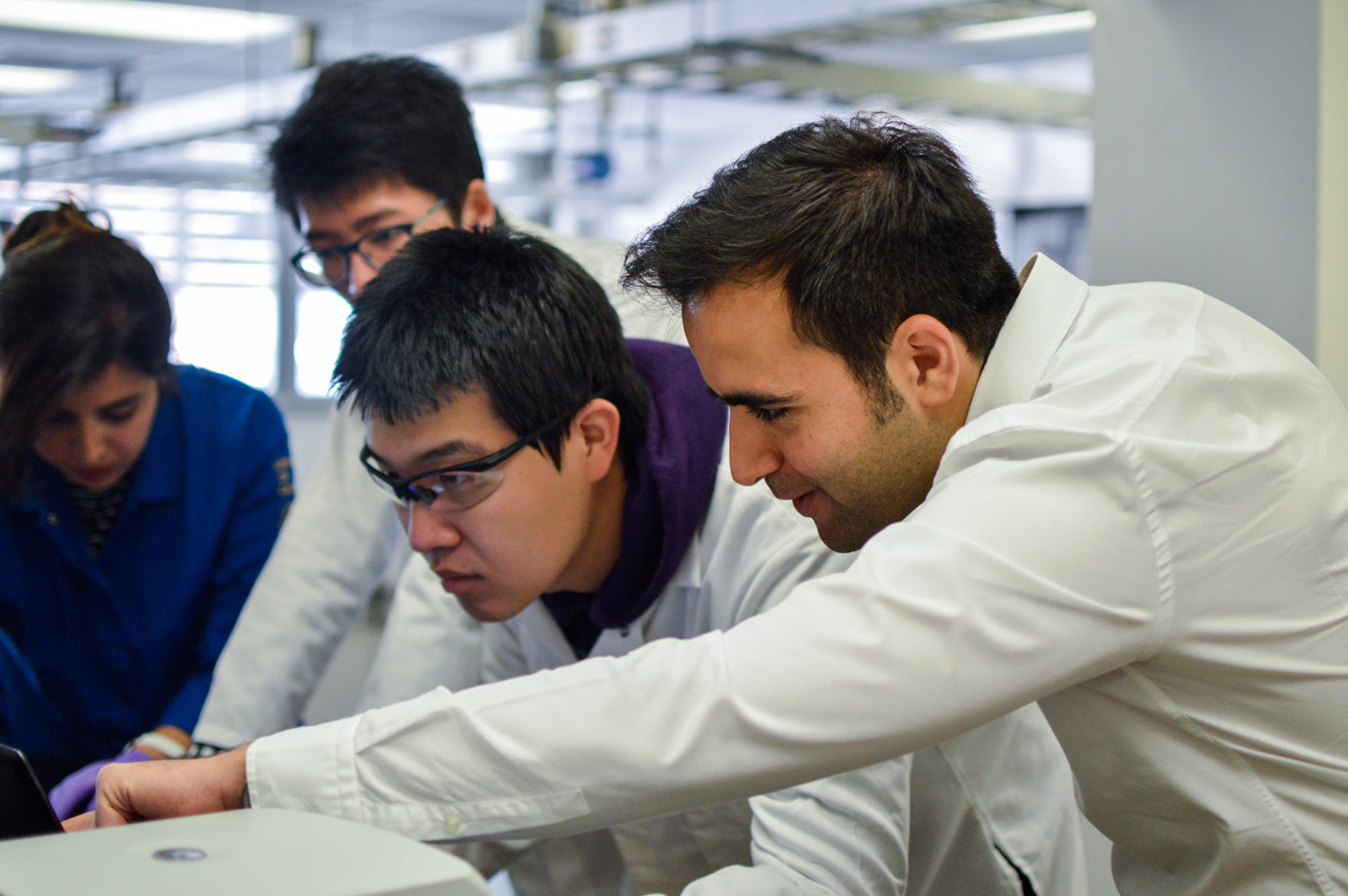UCLA researchers develop wristband that gathers health data from sweat

Sam Emaminejad, one of the project leaders for the development of sweat-based diagnostic technology, shows a graduate student a technique for developing the wristband. (Katherine Zhuo/Daily Bruin)
By Deanna Necula
May 11, 2017 11:30 p.m.
UCLA researchers are using sweat to diagnose and track diseases such as cystic fibrosis and diabetes.
The researchers developed a wearable wristband that continuously gathers health-related data from sweat, said Sam Emaminejad, assistant professor of electrical engineering at UCLA and lead author of the researchers’ study published in 2016.
“Sweat is a rich source of information,” Emaminejad said. “It contains key molecules called biomarkers, such as electrolytes and metabolites, that act as health indicators.”
He said the wealth of diagnostic information sweat contains was previously inaccessible because patients needed to engage in physical activity to work up enough of a sweat for analysis, which often excluded newborns and the elderly. Instead, doctors gathered health information from other body fluids, such as blood or urine.
“Sweat is highly unexplored, not because it’s not useful, but because there was previously no device (to analyze it),” he said.
Emaminejad said the wristband stimulates the body’s sweat glands to produce a small amount of sweat on demand, rather than relying on sweat from physical activity. The wristband, which contains two electrodes, is placed over a layer of gel on the skin. The gel contains sweat-activating compounds that are released when the electrodes transmit an electrical impulse, triggering the sweat glands to secrete sweat that a sensor then analyzes.
He added the technology gathers crucial medical information without breaking the skin, and importantly, without requiring a visit to the doctor’s office. Alternate methods of acquiring the same information, such as blood tests, typically breach the skin and need to be administered by medical personnel.
Emaminejad said patients diagnosed with cystic fibrosis especially benefit from the technology.
Cystic fibrosis is currently treated with a drug that only works in a fraction of patients, so it is important to assess whether or not the drug proves effective in a particular individual, he said. The sweat technology allows doctors to continuously track chloride ion levels in a patient, since spikes in chloride levels are often associated with cystic fibrosis flare-ups.
Gary Mathern, director of epilepsy surgery at UCLA and a collaborator on the project, said the technology would be most useful for diabetics. Individuals with diabetes either need to frequently inject themselves with insulin or regularly check their blood glucose levels to adjust the dosage of their insulin pumps.
Mathern said sweat technology could be linked to a patient’s insulin pump so they would no longer need to frequently check their blood glucose levels. Instead, the device would continuously monitor glucose levels and transmit the information to the insulin pump to deliver the correct dosage when required. He added further scientific studies will be needed to determine whether there is a reliable correlation between blood glucose levels and glucose levels in sweat.
[Related: UCLA scientists develop method to predict diseases by testing saliva]
Emaminejad added he expects the technology will be used both in medical settings and among the public. He said scientific studies that reveal correlations between biomarkers and diseases will allow the wristband to interpret biomarker status updates for users with no medical background.
Omai Garner, assistant professor of pathology and laboratory medicine, said he thinks the technology will be ready for clinical testing within the next three years.
“We’re becoming more attached to our technology,” Garner said. “IPhones can already monitor many health parameters, and it’s only a natural progression from there. We want to incorporate (this type of personalized medicine) in a larger setting, not just when the patient shows up at the doctor’s office.”
He added the device could also be used to measure for day-to-day activities, such as nutrition and exercise, to stave off a number of diseases. The information could then be transmitted via Bluetooth to a doctor’s office for regular monitoring.
“We have a chronic disease problem in the United States, and we’re spending (a lot) on heart disease and diabetes,” he said. “The solution is to find a way early on to measure and control behavior so they don’t progress to that point.”
Garner said he thinks the device could also be used to detect an oncoming heart failure by measuring levels of the chemical troponin, which spikes before a heart attack.
Mathern said the device could even be linked to a system that determines whether or not levels of a particular biomarker are too high or low and informs the patient to seek medical attention immediately.
He said the device could even be used as a form of birth control. If researchers can find a biomarker that acts as a reliable indicator of estrogen levels, it could be used in conjunction with body temperature to let women know when they are at their most fertile.
“Who knows what other biomarkers could be identified?” he added. “This is a whole new world.”


